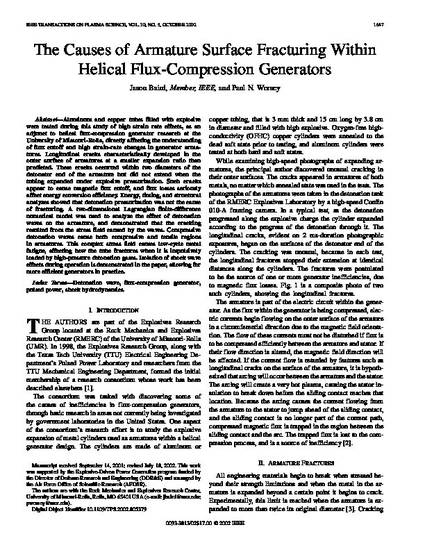
Aluminum and copper tubes filled with explosive were tested during this study of high strain rate effects, as an adjunct to helical flux-compression generator research at the University of Missouri-Rolla, directly affecting the understanding of flux cutoff and high strain-rate changes in generator armatures. Longitudinal cracks characteristically developed in the outer surface of armatures at a smaller expansion ratio than predicted. These cracks occurred within two diameters of the detonator end of the armature but did not extend when the tubing expanded under explosive pressurization. Such cracks appear to cause magnetic flux cutoff, and flux losses seriously affect energy conversion efficiency. Energy, timing, and structural analyzes showed that detonation pressurization was not the cause of fracturing. A two-dimensional Lagrangian finite-difference numerical model was used to analyze the effect of detonation waves on the armature, and demonstrated that the cracking resulted from the stress field caused by the waves. Compressive detonation waves cause both compressive and tensile regions in armatures. This complex stress field causes low-cycle metal fatigue, affecting how the tube fractures when it is impulsively loaded by high-pressure detonation gases. Isolation of shock wave effects during operation is demonstrated in the paper, allowing for more efficient generators in practice.
- Aluminum Tubes,
- Armature Surface Fracturing,
- Compressive Detonation Waves,
- Compressive Regions,
- Copper Tubes,
- Cracks,
- Detonation Waves,
- Detonator End,
- Energy Conversion Efficiency,
- Expansion Ratio,
- Exploding Wires,
- Explosive,
- Explosive Pressurization,
- Finite Difference Methods,
- Flux Losses,
- Helical Flux-Compression Generator,
- Helical Flux-Compression Generators,
- High Strain Rate Effects,
- High Strain-Rate Changes,
- High-Pressure Detonation Gases,
- Longitudinal Cracks,
- Low-Cycle Metal Fatigue,
- Magnetic Flux,
- Magnetic Flux Cutoff,
- Outer Surface,
- Pulsed Power Supplies,
- Shock Hydrodynamics,
- Shock Wave Effects,
- Shock Wave Effects Isolation,
- Structural Analyzes,
- Tensile Regions,
- Tube Fractures,
- Two-Dimensional Lagrangian Finite-Difference Numerical Model
Available at: http://works.bepress.com/paul-worsey/58/
